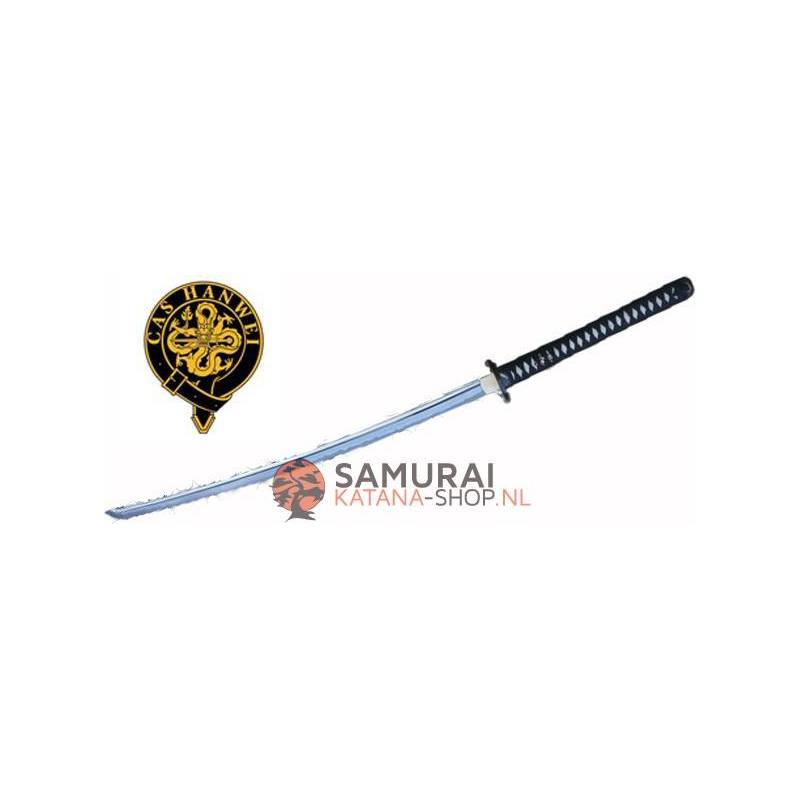
















The Tokugawa Katana has a hand-forged steel blade has a prominent gunome hamon and is provided with a bo-hi or longitudinal groove.
Hanwei wants to honor the famous Tokugawa shoguns through this katana. The Tokugawa were a dynasty of shoguns who gave their name to the Tokugawa shogunate. The Tokugawa shogunate followed the Sengoku period. The Tokugawa family ruled Japan from 1600, after the Battle of Sekigahara, until the Meiji Restoration in 1867.
Tokugawa Ieyasu is one of the most famous samurai in history due to his unwavering supremacy as the first shogun in the Edo period (1603-1868). He is often admired for his patience. While the other Samurai lords ruled dozens of states, Ieyasu waited for the time to turn everything around.
He began to expand his military authority in solidarity with the Oda clan from the late 1560s until Oda Nobunaga was passed over by treason. After that, the Tokugawa clan joined the Toyotomi clan alliance to help Toyotomi find their way to the king of the new order and further develop the Tokugawa empire.
After Mr. Toyotomi Hideyoshi passed away, Ieyasu finally said goodbye to the Toyotomi clan and started the battle of Sekigahara against Toyotomi, which divided the entire country in half.
After winning this battle, Ieyasu established the most important samurai regime in history, the Edo government. At this time, the shogun was effectively the sole ruler of the country. The emperor was in a kind of "golden captivity" in his court in Kyoto, without any power, and the shogun in Edo ruled the country. The Tokugawa period in Japanese history is also known as the Edo period.
The Tokugawa Katana has a tsuba in which Shogun Tokugawa is holding a war fan while the blade side of the tsuba shows a Japanese village. The fuchi and kashira have the Kyudo theme and show Japanese arches. Kyduo means the way of bow.
The tsuka is wrapped in black cotton with white same (rayskin) which is wrapped very tightly and feels nice. A meticulously detailed golden aoi menuki.
The 69 cm hand-forged steel blade has a prominent gunome hamon and is provided with a bo-hi or longitudinal groove.
A black glossy saya prevents staining with a black sageo.
This katana fits perfectly in the dojo, at home or in the office, but is an extremely functional sword.
Specifications
Hand Forged 65Mn Blade
Black glossy saya
Shinken (sharp katana)
battle ready
Full Tang with bo-hi
Total: 105 cm
Blade length: 69 cm
Shaku: 2.28
Tsuka/handle length: 33,5cm
POB: 12cm
Motohaba (bottom width): 3 cm
Motokasane (bottom blade thickness): 6 mm
Sakihaba (yokote width): 2 cm
Sakikasane (yokote thickness): 5 mm
Weight: 1070 grams
Specs will vary slightly from piece to piece.
65Mn is a readily-available steel that is formulated to provide good wear resistance and hardness. The medium-high carbon content makes for a high degree of toughness and resilience, while the manganese, in addition to improving these properties, improves the hot-working characteristics of the steel, making it an excellent candidate for forged sword blades. 65Mn Steel Composition: 0.62-0.7C 0.9-1.2Mn 0.17-0.37Si